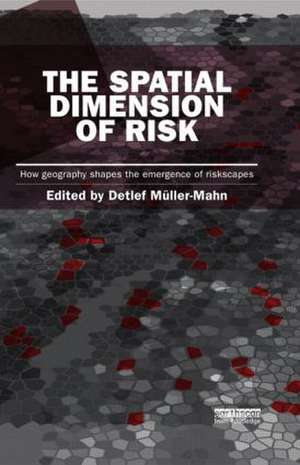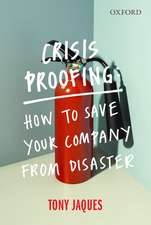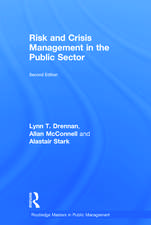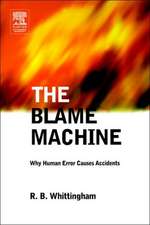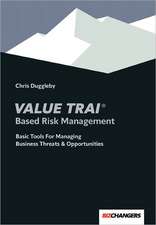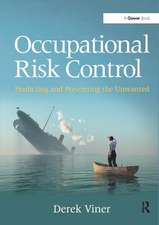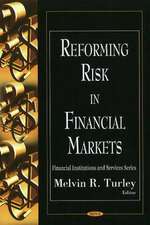The Spatial Dimension of Risk: How Geography Shapes the Emergence of Riskscapes: Earthscan Risk in Society
Editat de Detlef Müller-Mahnen Limba Engleză Paperback – 22 mai 2015
| Toate formatele și edițiile | Preț | Express |
|---|---|---|
| Paperback (1) | 448.86 lei 43-57 zile | |
| Taylor & Francis – 22 mai 2015 | 448.86 lei 43-57 zile | |
| Hardback (1) | 1067.49 lei 43-57 zile | |
| Taylor & Francis – 6 noi 2012 | 1067.49 lei 43-57 zile |
Din seria Earthscan Risk in Society
-
 Preț: 317.61 lei
Preț: 317.61 lei -
 Preț: 346.17 lei
Preț: 346.17 lei -
 Preț: 310.31 lei
Preț: 310.31 lei -
 Preț: 372.90 lei
Preț: 372.90 lei -
 Preț: 300.41 lei
Preț: 300.41 lei - 12%
 Preț: 325.84 lei
Preț: 325.84 lei -
 Preț: 376.70 lei
Preț: 376.70 lei - 12%
 Preț: 329.14 lei
Preț: 329.14 lei - 16%
 Preț: 274.06 lei
Preț: 274.06 lei -
 Preț: 410.46 lei
Preț: 410.46 lei -
 Preț: 452.31 lei
Preț: 452.31 lei -
 Preț: 416.09 lei
Preț: 416.09 lei - 22%
 Preț: 323.32 lei
Preț: 323.32 lei -
 Preț: 416.22 lei
Preț: 416.22 lei -
 Preț: 347.80 lei
Preț: 347.80 lei - 17%
 Preț: 258.30 lei
Preț: 258.30 lei -
 Preț: 197.69 lei
Preț: 197.69 lei - 15%
 Preț: 705.64 lei
Preț: 705.64 lei - 15%
 Preț: 431.25 lei
Preț: 431.25 lei - 18%
 Preț: 1119.52 lei
Preț: 1119.52 lei -
 Preț: 497.92 lei
Preț: 497.92 lei - 18%
 Preț: 1008.48 lei
Preț: 1008.48 lei -
 Preț: 448.38 lei
Preț: 448.38 lei - 15%
 Preț: 435.36 lei
Preț: 435.36 lei -
 Preț: 416.22 lei
Preț: 416.22 lei - 18%
 Preț: 1003.12 lei
Preț: 1003.12 lei -
 Preț: 409.48 lei
Preț: 409.48 lei - 25%
 Preț: 683.99 lei
Preț: 683.99 lei -
 Preț: 451.36 lei
Preț: 451.36 lei -
 Preț: 391.34 lei
Preț: 391.34 lei - 26%
 Preț: 765.45 lei
Preț: 765.45 lei
Preț: 448.86 lei
Nou
Puncte Express: 673
Preț estimativ în valută:
85.89€ • 89.90$ • 71.49£
85.89€ • 89.90$ • 71.49£
Carte tipărită la comandă
Livrare economică 31 martie-14 aprilie
Preluare comenzi: 021 569.72.76
Specificații
ISBN-13: 9781138900943
ISBN-10: 113890094X
Pagini: 264
Dimensiuni: 156 x 234 x 15 mm
Greutate: 0.44 kg
Ediția:1
Editura: Taylor & Francis
Colecția Routledge
Seria Earthscan Risk in Society
Locul publicării:Oxford, United Kingdom
ISBN-10: 113890094X
Pagini: 264
Dimensiuni: 156 x 234 x 15 mm
Greutate: 0.44 kg
Ediția:1
Editura: Taylor & Francis
Colecția Routledge
Seria Earthscan Risk in Society
Locul publicării:Oxford, United Kingdom
Cuprins
Preface 1. Space Matters! Impacts for Risk Governance 2. Riskscapes: The Spatial Dimensions of Risk 3. A Place for Space in Risk Research – The Example of Discourse Analysis Approaches 4. Risk, Space and System Theory: Communication and management of natural hazards 5. The Certainty of Uncertainty: Topographies of risk and landscapes of fear in Sri Lanka’s civil war 6. Anxiety and Risk: Pandemics in the 21st century 7. Ungoverned Territories – The construction of spaces of risk in the ‘War on Terrorism’ 8. Spaces of Risk and Cultures of Resilience – HIV/AIDS and Adherence in Botswana 9. Risk as a Technology of Power: FRONTEX as an example of the de-politicization of EU migration regimes 10. An impossible site? Understanding risk and its geographies in Goma, Democratic Republic of Congo 11. Boundary-making as a Strategy for Risk Reduction in Conflict-prone Spaces 12. Bethinking Oneself of the Risk of (Physical) Geography 13. Space and Time: Coupling dimensions in natural hazard risk management? 14. Making Sense of the Spatial Dimensions of Risk
Notă biografică
Detlef Müller-Mahn is Professor of Social Geography and Director of ZENEB (Center for Natural Risks and Development Bayreuth) at the University of Bayreuth, Germany.
Recenzii
‘The Spatial Dimension of Risk offers fresh, practical ways of seeing risk, governance and space. It combines previously separate approaches: sociology of risk, geography of hazard and politics of policy. The authors invite us to think about war, flood, disease and terrorism in new ways – changing our thought as profoundly as Beck’s ‘Risk Society’ 20 years ago.’ – Benjamin Wisner, disaster management consultant and author of Disaster Risk Reduction: Cases from Urban Africa (Earthscan 2009), Handbook of Hazards and Disaster Risk Reduction (Routledge 2011) and Disaster Management: International Lessons in Risk Reduction, Response and Recovery (upcoming Routledge 2013)
‘The book gives the floor to a central dimension of risk, namely its spatiality. Spatiality comes in many different disguises, in the Global South as well as in the North, be it state border policies, propagation of contagious diseases, distribution of drought or landslide risk, or the question on which scale a risk should be managed in a most optimal way. With the concept of ‘Riskscapes’, the book provides an innovative and comprehensive frame for these widely diverse aspects of risk.’ – Jakob Rhyner, Director of the United Nations University Institute for Environment and Human Security and Vice Rector in Europe of the United Nations University
'This is an important book to read if you are involved in risk management and or spatial information systems like GIS. It will challenge conventional thinking and cause the reader to think about risk in new ways. As a result, it will lead to thinking about developing new applications that are oriented to risk management. The editor has done an excellent job pulling this book together. You will not only learn from this book, but it will likely further your career with the content embedded between the covers. One of the best books on spatial information you can read.' – Jeff Thurston, 3D Visualization World
‘The book gives the floor to a central dimension of risk, namely its spatiality. Spatiality comes in many different disguises, in the Global South as well as in the North, be it state border policies, propagation of contagious diseases, distribution of drought or landslide risk, or the question on which scale a risk should be managed in a most optimal way. With the concept of ‘Riskscapes’, the book provides an innovative and comprehensive frame for these widely diverse aspects of risk.’ – Jakob Rhyner, Director of the United Nations University Institute for Environment and Human Security and Vice Rector in Europe of the United Nations University
'This is an important book to read if you are involved in risk management and or spatial information systems like GIS. It will challenge conventional thinking and cause the reader to think about risk in new ways. As a result, it will lead to thinking about developing new applications that are oriented to risk management. The editor has done an excellent job pulling this book together. You will not only learn from this book, but it will likely further your career with the content embedded between the covers. One of the best books on spatial information you can read.' – Jeff Thurston, 3D Visualization World
Descriere
Through its exploration of the spatial dimensions of risk, this book offers a brand new approach to theorizing risk, and significant improvements in how to manage, tolerate and take risks. A broad range of risks are examined, including natural hazards, climate change, political violence, and state failure.
